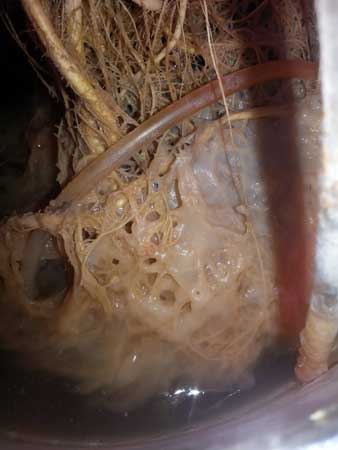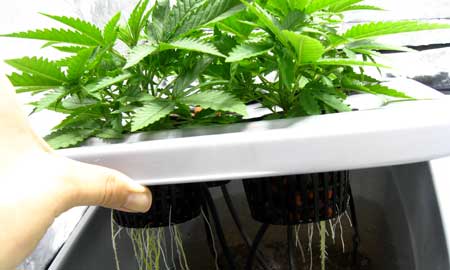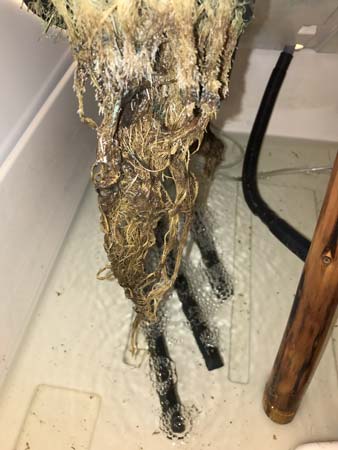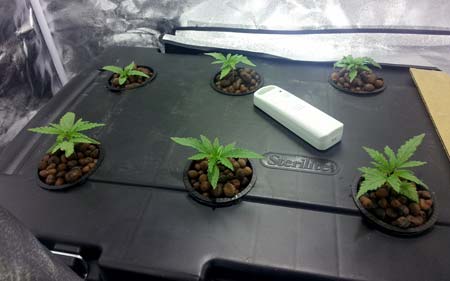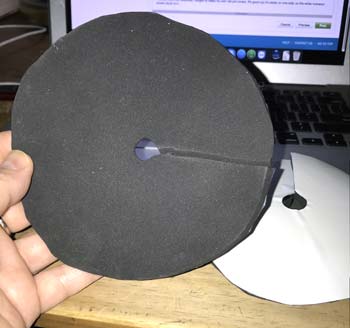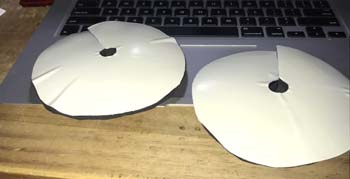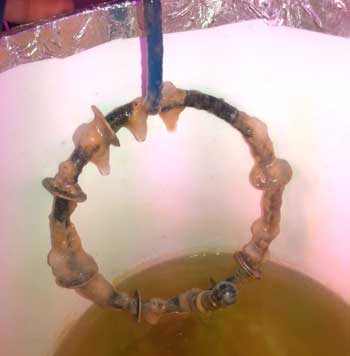by Nebula Haze (A huge thanks to alltatup, our resident DWC expert on fixing light leaks, for helping put this article together)
The roots of your cannabis plants don’t like light even at the best of times, which is reason enough to light-proof your DWC reservoir. But to make matters more serious, any bad organisms in the tank that get access to heat and light may start multiplying. When left unchecked, these organisms can infect your roots and give your plant the dreaded root rot or a gross algae bloom!
Uhhhhh…. a slimy algae bloom caused by a light leak
Hydroponic cannabis growers want it to be completely pitch black in their DWC reservoirs. You should not be able to see even a tiny bit of light where your roots are.
No Light Should Get in the Reservoir!
Even with a pre-fabricated grow box, you have to check for light leaks. And fix them. I now have two grow boxes, and I had to fix light leaks in both of them. Grumble grumble; that was NOT what I shelled out all the money for!!!
~Alltatup, Experienced Cannabis DWC Grower
This brown algae bloom attacked Alltatup’s plants before she fixed the light leaks
In order to accomplish a totally dark reservoir for your marijuana plants, here are some things to keep in mind:
First, Check Thoroughly for Light Leaks
Checking for light leaks means you have to get down on your back, usually on the floor, and peer up from below at the interior of the reservoir. You won’t find all the leaks just by looking down from above.
Consider the Material & Thickness of the Reservoir Tub
If building your own DWC system, consider the construction of the tub.
- Thickness – A thicker tub is more sturdy and filters more light. Go for a thicker material when possible!
- Color – Black plastic is great at blocking light, and black tubs usually let less light through than pale-colored tubs. However, pale-colored tubs can also be light-proof if the plastic is thick enough. Try to pick the most light-proof material available. To test: Turn on the flashlight app on your phone and hold it up to the tub. If you look at the other side and can’t see any light, you know that the tub will work.
- Reflectivity – Pale colors tend to reflect back more heat and light, but you can always increase the reflectivity later by covering the lid with a reflective material.
You don’t need to worry about searching for light leaks when using a dark, thick and sturdy tub as your water reservoir
Light-Proofing Net Pots
It’s important to make sure all your unused net pot holes are covered, even if the net pots are filled with clay pebbles. Some light can still get through.
Don’t try to block light with flimsy materials like paper plates; if you hold one up to a light source you can easily see that plenty of light still shines through!
Possible Materials for Light-Proofing Net Pots:
- Neoprene net pot inserts – Instead of filling your unused net pots with clay pebbles, you could install one of these specially made inserts that prevent light from getting through. Choose a size that is the same width as your net pot, though you may need to trim it a little to get it to fit correctly.
- Net pot covers (sometimes called “light guards” or “root guard lids”) are another great option to block light. They are basically custom-sized light-colored plates that reflect light back up and away from the roots.
- You can use these by themselves, or together
You can make net pot covers at home from a sheet of neoprene. Use a net pot to draw circles, then cut your DIY covers out
These neoprene sheets come with a sicky side. You can use the adhesive to attach a white net pot cover, to reflect back even more light and heat.
Tape is an Easy Way to Repair Light Leaks
Once you’ve spotted a light leak, it’s time to fix it! One way to repair light leaks is to cover the surface with something opaque like reflective tape or black electrical tape.
Use Dark (Light-Proof) Tubing
Use black tubing if possible. It’s just one more way to prevent light from reaching your water.
Don’t Ignore Light Leaks!
All the Hydroguard, Great White, SM-90, H2O2 or other root supplements in the world often won’t solve a root rot problem if there’s a light leak.
Learn More About Cannabis Root Rot and How to Prevent It
Don’t let this happen to your DWC reservoir!

